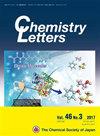Formation of Novel Polycyclic Aromatic Compounds by Scholl Reactions of Di(1-anthryl) Ketones via Cyclization and Rearrangement
IF 1.1
4区 化学
Q3 CHEMISTRY, MULTIDISCIPLINARY
引用次数: 0
Abstract
The Scholl reactions of di(1-anthryl) ketones were performed with chloranil under an acidic condition. The reaction of the parent ketone gave a cyclized product containing a seven-membered ring, which was enantiomerically separable. In contrast, the reaction of 4-(mesityloxy)-1-anthryl derivative mainly afforded an unexpected polycyclic aromatic ketone consisting of eight six-membered rings via skeletal rearrangement. The structure and properties of these products and the reaction mechanism are reported. Two di(1-anthryl) ketones gave different dehydrocyclization products upon treatment with chloranil. In particular, the (2,4,6-trimethylphenyl)oxy substituted derivative produced a novel aromatic ketone via unexpected skeletal rearrangement. This result is in contrast to that of the substituent free derivative, which formed a simple cyclization product with a helical structure.二(1-蒽基)酮经环化重排反应生成新型多环芳香族化合物
二(1-蒽基)酮与氯胺在酸性条件下进行了Scholl反应。母体酮反应得到含七元环的环化产物,该环在对映体上可分离。而4-(甲三甲氧基)-1-蒽基衍生物的反应主要是通过骨架重排生成由8个六元环组成的意外多环芳酮。报道了这些产物的结构、性能和反应机理。两种二(1-蒽基)酮经氯胺处理后产生不同的脱氢环产物。特别是,(2,4,6-三甲基苯基)氧取代衍生物通过意外的骨架重排产生了一种新的芳香酮。这一结果与无取代基衍生物的结果相反,后者形成了具有螺旋结构的简单环化产物。
本文章由计算机程序翻译,如有差异,请以英文原文为准。
求助全文
约1分钟内获得全文
求助全文
来源期刊

Chemistry Letters
化学-化学综合
CiteScore
3.00
自引率
6.20%
发文量
260
审稿时长
1.2 months
期刊介绍:
Chemistry Letters covers the following topics:
-Organic Chemistry-
Physical Chemistry-
Inorganic Chemistry-
Analytical Chemistry-
Materials Chemistry-
Polymer Chemistry-
Supramolecular Chemistry-
Organometallic Chemistry-
Coordination Chemistry-
Biomolecular Chemistry-
Natural Products and Medicinal Chemistry-
Electrochemistry
 求助内容:
求助内容: 应助结果提醒方式:
应助结果提醒方式:


